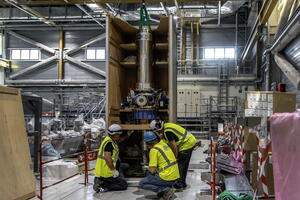Awe and pride in the Radiofrequency Building
They knew what was in the box. They had contributed to the component’s conception and design, followed the progress of fabrication from prototype to reality, and anxiously waited for delivery. How it worked, delivering highly concentrated fluxes of energy, contained no secrets for them. Still, when the big crate was opened and raised to vertical, revealing its contents, the feeling this morning on the third floor of the Radiofrequency Building was one of awe and pride. What a strange-looking, out-of-this-world object!
On Monday 7 July, the first of the many gyrotrons required for plasma heating by way of a technique called electron cyclotron resonance heating was unpacked and positioned on its support structure. The component was delivered by Japan in February 2022, part of a global procurement program for gyrotrons that also involves Russia, Europe and India.
Gyrotrons have historically had only a few applications, which are essentially concentrated in the realm of magnetic fusion and material processing—for instance growing crystal windows or special ceramics. A radically new application under development is the use of megawatt-class gyrotrons like ITER’s for providing access to deep geothermal heat without complex downhole equipment. Because they can focus tremendous amounts of energy on a determined surface, a bit like lasers, gyrotrons could drill kilometres deeper and faster than conventional techniques, avoiding tool wear and considerably reducing the activity’s environmental footprint.
Besides heating a plasma to hundreds of millions of degrees (no small feat!) this is what the device the teams were taking in and handling could do. Whether scientists from ITER, from Japan’s National Institutes for Quantum Science and Technology, or from the installation consortium Fincatieri, their awe and pride was understandable.


